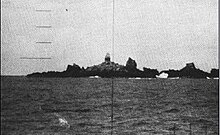Saint Peter and Saint Paul Archipelago
[3] It lies in the Intertropical Convergence Zone, a region of the Atlantic characterized by low average winds punctuated with local thunderstorms.
On April 20, 1511, a Portuguese Navy fleet composed of six caravels under the command of Captain Garcia de Noronha discovered the islets by accident while on their journey to India.
While navigating in the open sea late at night, the Saint Peter caravel, under the command of Captain Manuel de Castro Alcoforado, crashed against the islets.
[7] On the morning of February 16, 1832, the rocks were visited by Charles Darwin on the first leg of his voyage on HMS Beagle around the world.
[6] In 1942, during World War II, the islets were declared to be part of the Federal Territory of Fernando de Noronha (which also included the Rocas Atoll).
In early 1960, the rocks served as the starting-point and terminus for the first submerged circumnavigation of the world by the American nuclear-powered submarine USS Triton.
[10] By maintaining permanent occupation of the archipelago, the Brazilian Navy extends Brazil's Exclusive Economic Zone, territorial waters and airspace into the North Atlantic Ocean.
A fishing vessel located nearby rescued the researchers, who were then transferred to a Brazilian Navy patrol boat.
The nearest point in the Brazilian coast, is Cabo do Calcanhar, Rio Grande do Norte, approximately 1,010 kilometres (630 mi) from the archipelago.
Unlike submarine volcanoes, this ledge consists of two tabular elevations oriented east–west, presenting a shape similar to Brachiosaurus dinosaur whose head faces east.
On the flanks of the Archipelago, from sea level to a depth of 1,000 meters, high angle slopes occur, around 50º inclination.
These unstable submarine morphologies suggest that the uplift of the Archipelago originated from a recent tectonism, which continues until the present.
[22] The 1973 novel HMS Surprise by Patrick O'Brian describes a fictitious visit to one of the islands (called "St Paul's Rock" in the novel) by the character Dr Stephen Maturin.





